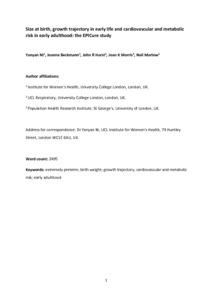Ni, Y; Beckmann, J; Hurst, JR; Morris, JK; Marlow, N
(2021)
Size at birth, growth trajectory in early life, and cardiovascular and metabolic risks in early adulthood: EPICure study.
Arch Dis Child Fetal Neonatal Ed, 106 (2).
pp. 149-155.
ISSN 1468-2052
https://doi.org/10.1136/archdischild-2020-319328
SGUL Authors: Morris, Joan Katherine
![[img]](https://openaccess.sgul.ac.uk/112298/1.hassmallThumbnailVersion/Accepted%20Version.pdf)  Preview |
|
PDF
Accepted Version
Available under License ["licenses_description_publisher" not defined].
Download (716kB)
| Preview
|
Abstract
OBJECTIVE: To investigate whether size at birth and growth trajectories in infancy and childhood are associated with determinants of cardiovascular and metabolic risks in young adults born extremely preterm (EP, <26 weeks of gestation). METHODS: We used longitudinal data from the EPICure study of 129 EP survivors up to 19 years in the UK and Ireland in 1995. Determinants of cardiovascular and metabolic risks at 19 years included the presence of metabolic syndrome, body mass index (BMI) and systolic blood pressure (SBP). Predictors were birth weight for gestation and gain in weight z-scores in the following periods: birth-postmenstrual age of 40 weeks (term), infancy (term-2.5 years), early childhood (2.5-6.0 years) and late childhood (6-11 years). RESULTS: Metabolic syndrome was present in 8.7% of EP participants at 19 years. Compared with subjects without metabolic syndrome, those with metabolic syndrome tended to have a smaller size at birth (difference in means: -0.55 SD, 95% CI -1.10 to 0.01, p=0.053) and a greater increase in weight z-scores from term to 2.5 years (difference in means: 1.00 SD, 95% CI -0.17 to 2.17, p=0.094). BMI at 19 years was positively related to growth from 2.5 to 6.0 years (β: 1.03, 95% CI 0.31 to 1.75, p=0.006); an inverse association with birthweight z-scores was found in the lower socioeconomic status group (β: -1.79, 95% CI -3.41 to -0.17, p=0.031). Central SBP was positively related to growth from 2.5 to 6.0 years (β: 1.75, 95% CI 0.48 to 3.02, p=0.007). CONCLUSION: Size at EP birth and increased catch-up in weight from 2.5 to 6.0 years were associated with BMI and central SBP in early adulthood.
Statistics
Item downloaded times since 20 Aug 2020.
Actions (login required)
 |
Edit Item |



